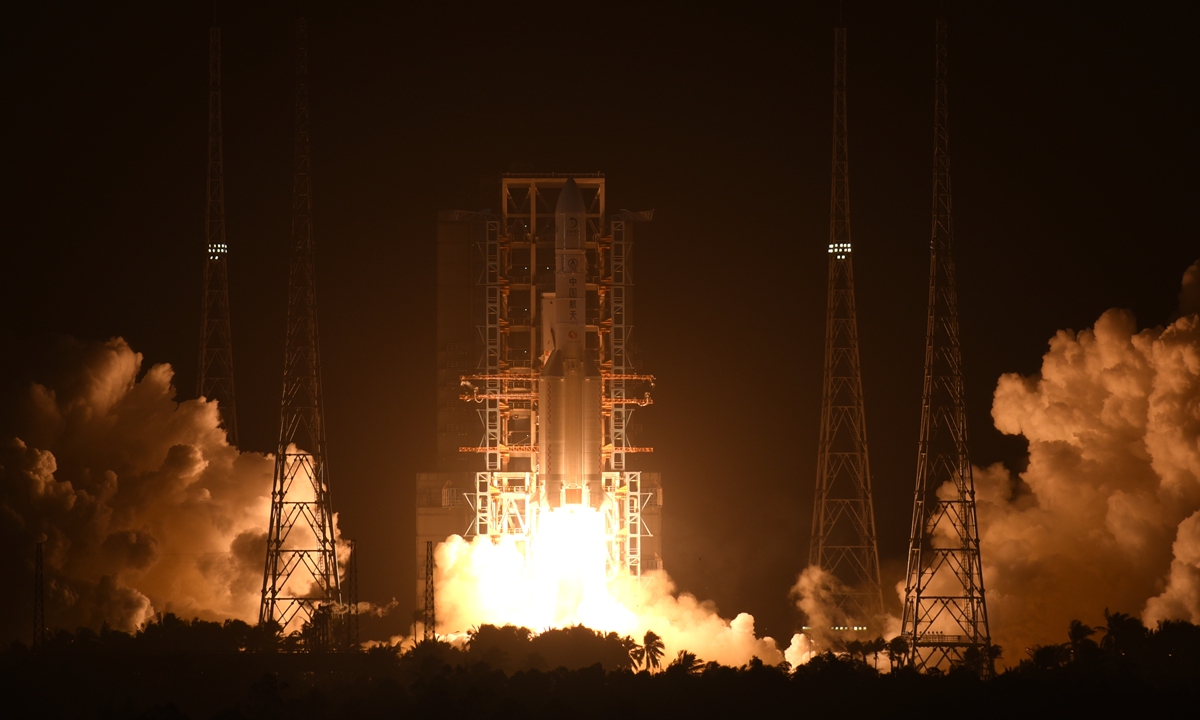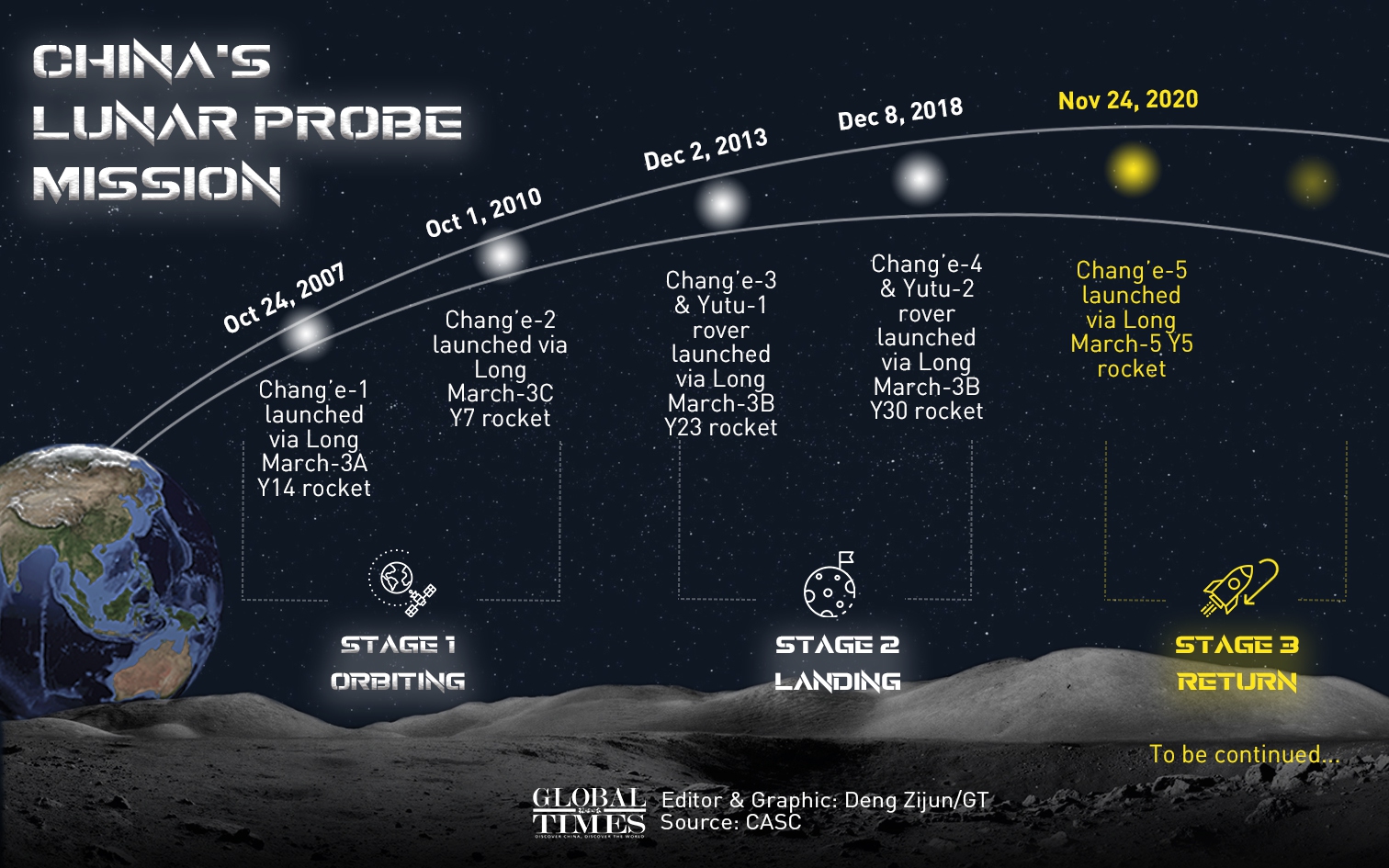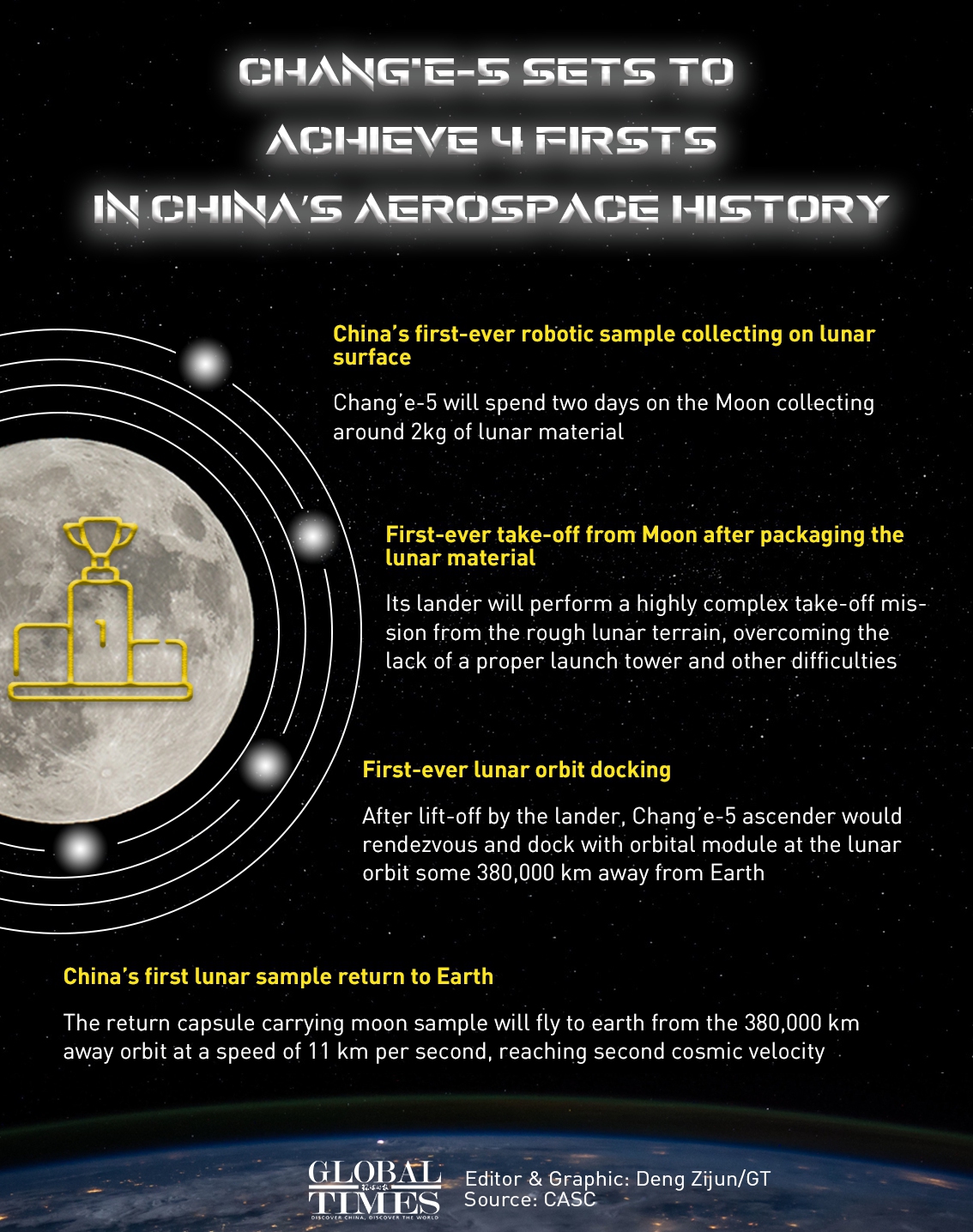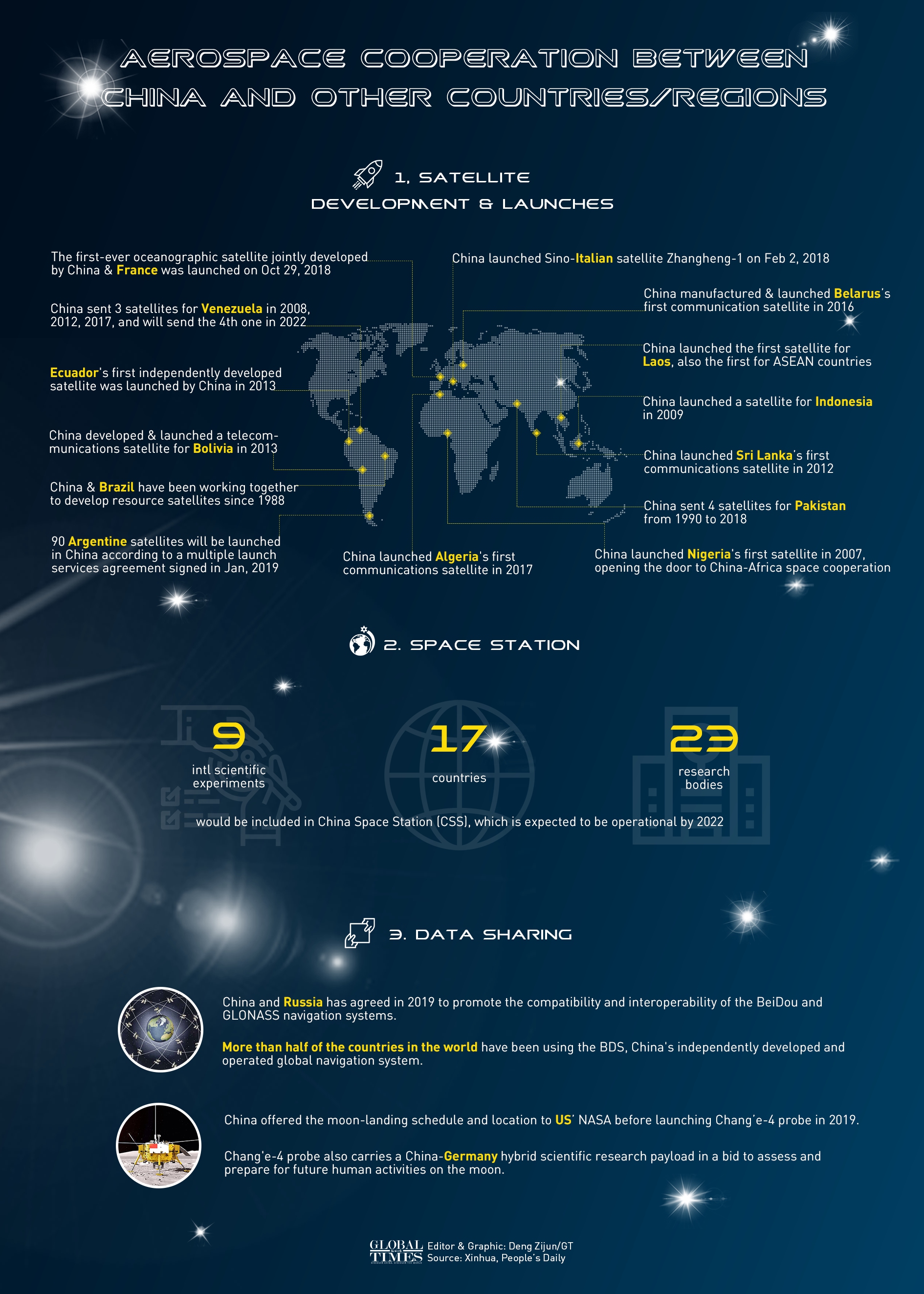Pre-dawn launch of China's ambitious lunar sample return excites the world
By Deng Xiaoci and Fan Anqi Source: Global Times Published: 2020/11/24 21:28:32 Last Updated: 2020/11/24 23:57:49
Experts cautious on NASA cooperation under Biden administration
00:00:00
/ 00:24

China launches Chang’e-5 mission via Long March-5 rocket to retrieve Moon rocks at Wenchang Space Launch Center from South China’s Hainan Province early Tuesday morning. Photo: Li Dike
Many Chinese space enthusiasts spent a sleepless night to witness the successful launch of the Chang'e-5 mission from the Wenchang Spacecraft Launch Site in Hainan just after 4.30 am (Beijing time), in what observers said is the boldest mission yet, and its first quest to retrieve extraterrestrial material and return it to the Earth.
The long wait for China's third moon mission has paid off. About 2,200 seconds after liftoff, the Chang'e-5 lunar probe separated from the rocket's first and second stages and entered the Earth-Moon transfer orbit with the perigee at 200 kilometers and the apogee at 410,000 kilometers. It takes around three days for the probe to reach the moon.
The Chang'e-5 probe is expected to carry out a lunar sample collection, takeoff from the moon, rendezvous and dock in lunar orbit and to undertake a high-speed reentry into the Earth's atmosphere, marking breakthroughs in China's aerospace history.
Sources close to the lunar probe mission told the Global Times that the Chang'e-5 probe is set to achieve four firsts in China's aerospace history.
It will conduct the first-ever robotic sample collection on the lunar surface, spending two Earth days on the Moon to drill down and collect around 2 kilograms of lunar material including rocks and other samples.
After packaging the lunar material, the probe's lander will perform a highly complex takeoff mission from the rough lunar terrain, overcoming the lack of a proper launch tower and other difficulties, which will also be a first.
A greater challenge lies in wait after the lander's liftoff, as the Chang'e-5 ascender will have to rendezvous and dock with the orbital module in lunar orbit some 380,000 kilometers from the Earth, which has never been done before.
Finally, the return capsule carrying moon samples will fly to the Earth from 380,000 kilometers away at a speed of 11 kilometers per second, reaching second cosmic velocity, also known as escape velocity which is needed to escape the gravitational pull of an object.
The whole mission is set last more than 20 days.
The Tuesday launch marked a good start, but the challenges of these firsts lie ahead, observers noted.

China's lunar probe mission Infographic: GT
Worldwide space event
The international community is also closely following China's remarkable achievement, and has sent congratulations upon the huge success.
US space agency NASA's Associate Administrator Thomas Zurbuchen tweeted that he looks forward to seeing how China's mission will advance the international science community. SpaceX CEO Elon Musk called the launch an "exciting" feat and one of the most challenging missions in aerospace history.
Media around the world hailed China's achievement, as Russia Today pointed out that China "sets incremental targets and goals, and they build on what they've achieved and make more ambitious targets." US-based media outlet ABC News cited Joan Johnson-Freese, a space expert at the US Naval War College, who commented on the technical complexity of Chang'e-5 as being "remarkable in many ways."

Infographic: GT
NASA's quick appeal
NASA addressed the probe's launch on Twitter shortly after the liftoff. However, the tweet is more of an appeal for China to share its data acquired from the mission with the rest of the world.
"We hope China shares its data with the global scientific community to enhance our understanding of the Moon like our Apollo missions did & the Artemis program will," read NASA's tweet.
In fact, before the US space agency's plea, Pei Zhaoyu, the mission spokesperson and deputy director of the Lunar Exploration and Space Program Center of the CNSA, told the media that concerning China's lunar exploration, China sets its own scientific and engineering goals but adheres "to the goals of peaceful development."
"After receiving lunar soil samples, we will disclose to the international community how to handle the regolith samples and will conduct research in accordance with that," the spokesperson said.
Pei in previous interviews said that China had launched initiatives in the international community, hoping to cooperate with countries around the world to build an international lunar research station.
"The current information sharing between China and the US in the field of aerospace is far from standing on equal ground. The US only seeks cooperation and data sharing with those who acquire unique breakthroughs in certain fields, but excludes countries with less advanced technologies," Song Zhongping, an aerospace observer and TV commentator, told the Global Times on Tuesday.
Future of China-US space cooperation
Although the 2020 US presidential election did not mention much about space policies, NASA is worried over Joe Biden's potential "softer touch" on the space cooperation issue with China, compared with the ongoing push of American space dominance and an increased funding for NASA under the Trump administration.
In 2018, Biden said that he "wanted to make China a full partner in space exploration, rather than a frustrated new entrant that had to catch up to the US."
In contrast, Trump announced earlier an additional $1.6 billion on top of the $21 billion budget in 2020 that would be allocated to NASA's manned lunar return program, continuing the institution's prioritization to return astronauts back to the moon.
Despite the dire difficulty brought about by the COVID-19 pandemic and the fact that China was once the hardest-hit country in the world by the global human health crisis, China has managed to not only rein in the virus, but also maintain its progressive pace in the space sector, with world-leading launch numbers and extremely high quality, underscoring its strong resilience and competitiveness.
China has launched the latest version of the BeiDou or BDS-3 system, its indigenous global navigation satellite system, which has been hailed by international space observers as the equivalent of the US-dominant GPS.
In July, China also launched the country's first-ever Mars probe codenamed Tianwe-1, ushering in a new interstellar chapter of China's aerospace, expanding the country's space exploration beyond the moon and toward the planets.
With the Tuesday launch, China became the only country in the world that has launched both Mars and lunar probes this year.
Construction of China's space station, slated to be operational by 2022, is also expected to commence next year, amid speculation that the International Space Station is nearing retirement.
NASA has indeed felt China's emerging power in the space sector, responding with anxious actions, analysts said.
Excluding China to date, the US space authorities under the Trump administration rolled out a legal blueprint codenamed the Artemis Accords for mining on the moon, proposing "safety zones" surrounding future moon bases in a bid to prevent damage or interference from rival countries and companies, with "like-minded" space partners such as Canada, Japan, European countries as well as the United Arab Emirates.
China has criticized the plan as a display of American space hegemony, in efforts to develop a new space version of an "Enclosure Movement" in pursuit of colonization and claiming sovereignty of the moon.
Faced with these challenges, China needs to maintain an open attitude that welcomes the international community to join forces in the development of space exploration, be it the building of space stations or deep-space exploration, Song said.
While asking other countries to open up and share its research results, the US has put a complete ban on any exchanges in aerospace studies with China, evident in the signing of the Cox Report, Song noted.
"For the US, science is marked with national boundaries. China must make its own way into space exploration and not count on others. When we make enough breakthroughs, more opportunities for cooperation with other countries will surface," he said.

Aerospace cooperation between China and other countries/regions Infographic: GT
Open to the world
China has signed cooperation framework agreements with multiple international space agencies, including the UN Office for Outer Space Affairs, Russia's state space corporation Roscosmos and the European Space Agency (ESA).
Its open attitude toward international space cooperation has already brought benefits to its foreign partners. China's last lunar mission, Chang'e-4, which made the first-ever soft landing on the far side of the moon, carried payloads developed by the Netherlands, Germany, Sweden and Saudi Arabia.
The Global Times has previously reported that even NASA cooperated on lunar research with China's Chang'e -4 probe in 2019, when the Chinese probe performed the world's first soft landing on the far side of the moon.
NASA was particularly interested in knowing how dust would move when the Chinese probe landed on the moon; and in response, China immediately offered its moon-landing schedule and location to the US Lunar Reconnaissance Orbiter in lunar orbit, Chinese officials revealed.
The ESA, French space agency and the Austrian Research Promotion Agency also participated in the China's Tianwen-1 Mars probe mission that launched on July 23 this year.
The China Manned Space Agency has also announced in June 2019 that nine international scientific experiments of 17 countries and 23 research bodies would be included on board the China Space Station.
China is also planning to open its Chang'e-6 lunar probe mission to international payloads. The orbiter and lander of the spacecraft will each reserve 10 kilograms for payloads, which will be selected from both domestic and foreign scientific research institutions.
Posted in: SOCIETY